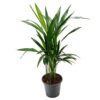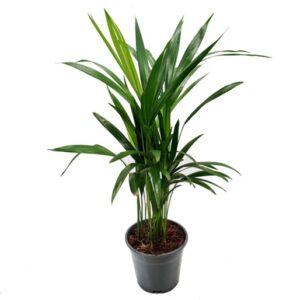Areca palm, also known as the Areca palm or Chrysalidocarpus lutescens, is a popular and graceful palm plant commonly used as an indoor and outdoor ornamental plant. It belongs to the Arecaceae family and is native to Madagascar and surrounding regions. These palms are valued for their attractive feathery fronds and ability to add a tropical touch to landscapes and interior spaces.
Care of Areca Palm:
Light : This palms prefer bright, indirect light. They can tolerate some direct sunlight, especially in the morning or late afternoon, but prolonged exposure to intense sunlight may scorch the leaves. Indoors, they do well in well-lit rooms away from direct sunlight or near windows with sheer curtains.
Temperature : This palms thrive in warm temperatures and do not tolerate cold or freezing conditions. They are best suited for tropical and subtropical climates and should be protected from frost.
Watering : Adequate watering is essential for these palms. They like to be kept consistently moist but not waterlogged. Allow the top inch of the soil to dry out before watering again. In indoor environments, it’s essential to maintain proper drainage to prevent root rot.
Humidity : These palms appreciate higher humidity levels, which mimic their native tropical habitats. Regular misting or placing a humidity tray nearby can help increase humidity levels.
Soil : A well-draining and nutrient-rich soil mix is ideal for Areca palms. A blend of regular potting soil with some sand or perlite for improved drainage works well.
Fertilization : These palms benefit from regular fertilization during their active growth season (spring and summer). A balanced, water-soluble fertilizer with macro and micronutrients is recommended, applied according to the manufacturer’s instructions.
Plant Characteristics of Areca Palm:
Fronds: These palms have pinnate fronds, meaning the leaflets are arranged on either side of a central rachis or stem, creating a feather-like appearance. The fronds are long, arching, and typically bright green, providing an elegant and tropical look to the plant.
Size: These palms can vary in size, depending on their age and growing conditions. Indoors, they usually reach a height of about 5 to 7 feet (1.5 to 2 meters), while outdoor specimens can grow much taller, up to 20 to 30 feet (6 to 9 meters).
Growth Habit: These palms have a clustering growth habit, meaning they produce multiple stems or trunks from a single base. This gives them a full and lush appearance.
Landscape Use of Areca Palm:
- Privacy Screen: Planting a row of Areca palms can create a natural privacy screen. Their dense foliage provides visual separation and can shield your outdoor space from neighboring properties or unsightly views.
- Accent Plant: Use these palms as accent plants in your garden or landscaping design. Their graceful, feathery fronds can add a touch of elegance and a tropical feel to various outdoor settings.
- Poolside Planting: These palms are well-suited for poolside landscaping. They can provide shade, create a relaxed atmosphere, and their non-invasive root system is less likely to damage pool structures.
- Shaded Patios and Decks: Plant these palms in large containers or directly in the ground around shaded patios, decks, or outdoor seating areas to create a comfortable and cool environment.
- Tropical Garden Theme: If you’re creating a tropical garden theme, Areca palms are a must-have. Combine them with other tropical plants, such as hibiscus, ti plants, or bird of paradise, to achieve an exotic and lush landscape.
- Understory Plant: In landscapes with taller trees or structures, these palms can be used as understory plants. They thrive in the filtered light conditions beneath taller vegetation.
- Group Planting: Cluster several Areca palms together in a landscaped area to create a dramatic effect. Groupings can make a bold statement in your landscape design.
- Container Gardens: Areca palms are suitable for container gardening. Placing them in large pots or decorative containers allows you to move them around the landscape, offering flexibility in your design.
- Mixed Planting Beds: Incorporate Areca palms into mixed planting beds alongside other tropical or subtropical plants. This adds texture and diversity to the garden.
- Botanical Gardens: Areca palms are often featured in botanical gardens and public spaces, where their beauty and tropical charm can be enjoyed by visitors.
- Educational Gardens: Use these palms in educational settings to teach people about tropical and subtropical plant species. They make for great additions to botanical and educational gardens.
When planting Areca palms outdoors, consider the local climate, as they are more suitable for warm and subtropical regions. They prefer well-draining soil, and while they can tolerate some direct sunlight, they thrive in filtered or indirect light conditions. Adequate watering, especially during hot and dry periods, is essential to maintain their lush appearance. Protect them from frost, and be mindful of their potential height as they can grow up to 20 feet or more in the right conditions.
In colder climates, these palms are commonly grown as indoor houseplants, adding a touch of the tropics to interior spaces.
They are also suitable for container gardening on patios, balconies, and decks, where their graceful fronds create a relaxing and inviting atmosphere.
Overall, the Areca palm is a charming and versatile plant that can bring a sense of the tropics to any landscape or interior setting. Its feathery fronds, combined with its low-maintenance requirements, make it a beloved choice for those seeking a lush and attractive ornamental palm.
Note:
You can find our other indoor plants and out door plants on our website
For further details you can contact our mobile or what’s app number +971 58 872 3434






